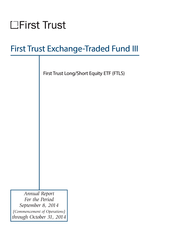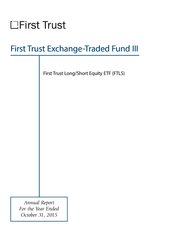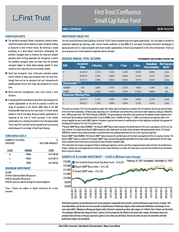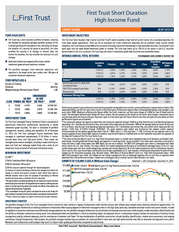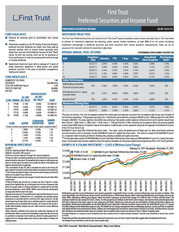First Trust Emerging Markets Local Currency Bond ETF – as of December 31, 2015
First Trust Portfolios
Description
First Trust Emerging Markets Local Currency Bond ETF
» Top Holdings (%)
» Portfolio Information
Number Of Holdings
Weighted Average Effective Duration¹
Weighted Average Maturity
Weighted Average Coupon
24
5.14 Years
6.86 Years
6.64%
» Top Currency Exposure (%)
Czech Republic, 2.40%, Due 09/17/2015
9.92
Indonesia Government, 8.375%, Due 03/15/2024
6.90
Nota do Tesouro Nacional, 10%, Due 01/01/2021
6.15
Poland Government Bond N/C, 5.50%, Due 10/25/2019 5.86
Turkey Government Bond, 10.5%, Due 01/15/2020
5.35
Republic of Philippines, 3.9%, Due 11/26/2022
5.23
Thailand Government Bond, 3.625%, Due 06/16/2023 4.68
Bono BCO Cent Chile Pes, 6%, Due 02/01/2021
4.63
Romania Government Bond, 5.85%, Due 04/26/2023 4.62
Israel Fixed Bond, 6.25%, Due 10/30/2026
4.61
» Maturity Exposure (%)
» Top Country Exposure (%)
Czech Republic
Poland
Indonesia
Brazil
Mexico
Turkey
Philippines
Thailand
Chile
Romania
As of 12/31/15
10.19
9.97
9.88
9.17
8.30
5.50
5.38
4.81
4.76
4.75
BRL
MXN
PLN
CZK
IDR
ZAR
TRY
PHP
RON
CLP
11.20
9.90
9.90
9.80
9.80
5.70
5.60
5.30
4.80
4.70
» Credit Quality (%)²
0 - 5.99 Years
3 Years
6 - 5 Years
3 6.99 Years
7 - 7.99 Years
5 7 Years
8 - 10 Years
7 8.99 Years
9 --9.99 Years
10 15 Years
10 - Years Years
15+ 14.99
Cash
7.18
7.60
6.63
28.30
11.63
13.60
21.27
37.40
11.15
6.70
36.04
5.60
0.80
Cash
AAA
AA
A+
A
ABBB+
BBB
BBBBB+
0.80
9.50
14.50
4.60
17.90
5.70
7.50
5.20
19.90
14.40
¹A measure of a bond’s sensitivity to interest rate changes that reflects the change in a bond’s price given a change in yield.
²The ratings are by Standard & Poor’s. A credit rating is an assessment provided by a nationally recognized statistical rating organization (NRSRO), of the creditworthiness of an issuer with
respect to debt obligations. Ratings are measured on a scale that generally ranges from AAA (highest) to D (lowest). Investment grade is deï¬ned as those issuers that have a long-term credit
rating of BBB- or higher.
“NR” indicates no rating. The credit ratings shown relate to the credit worthiness of the issuers of the underlying securities in the Fund, and not to the Fund or its shares. Credit ratings are subject to change. You should consider the fund’s investment objectives, risks, and charges and expenses carefully before investing.
Contact First Trust Portfolios L.P. at 1-800-621-1675 or visit www.ftportfolios.com to obtain a prospectus or summary prospectus which contains this and other information about the fund. The prospectus or summary prospectus should be read carefully before investing. ETF Characteristics The fund lists and principally trades its shares on The Nasdaq Stock Market LLC. Investors buying or selling fund shares on the secondary market may incur customary brokerage commissions.
Market prices may differ to some degree from the net asset value of the shares. Investors who sell fund shares may receive less than the share’s net asset value. Shares may be sold throughout the day on the exchange through any brokerage account. However, unlike mutual funds, shares may only be redeemed directly from the fund by authorized participants, in very large creation/redemption units. Risk Considerations The fund’s shares will change in value, and you could lose money by investing in the fund. One of the principal risks of investing in the fund is market risk.
Market risk is the risk that a particular security owned by the fund, fund shares or securities in general may fall in value. The fund is subject to management risk because it is an actively managed portfolio. In managing the fund’s investment portfolio, the advisor will apply investment techniques and risk analyses that may not have the desired result. There can be no guarantee that the fund will meet its investment objective. Investments in sovereign bonds involve special risks because the governmental authority that controls the repayment of the debt may be unwilling or unable to repay the principal and/or interest when due.
In times of economic uncertainty, the prices of these securities may be more volatile than those of corporate debt obligations or of other government debt obligations. High-yield securities, or “junk” bonds, are subject to greater market fluctuations and risk of loss than securities with higher ratings, and therefore, may be highly speculative. These securities are issued by companies that may have limited operating history, narrowly focused operations, and/or other impediments to the timely payment of periodic interest and principal at maturity. Illiquid securities involve the risk that the securities will not be able to be sold at the time desired by the fund or at prices approximately the value at which the fund is carrying the securities on its books. The fund is subject to credit risk, call risk, income risk and interest rate risk. Credit risk is the risk that an issuer of a security will be unable or unwilling to make dividend, interest and/or principal payments when due and that the value of a security may decline as a result.
Call risk is the risk that if an issuer calls higher-yielding debt instruments held by the fund, performance could be adversely impacted. Income risk is the risk that income from the fund’s fixed-income Not FDIC Insured • Not Bank Guaranteed • May Lose Value investments could decline during periods of falling interest rates. Interest rate risk is the risk that the value of the fixed-income securities in the fund will decline because of rising market interest rates. An investment in a fund containing securities of non-U.S.
issuers is subject to additional risks, including currency fluctuations, political risks, withholding, the lack of adequate financial information, and exchange control restrictions impacting non-U.S. issuers. These risks may be heightened for securities of companies located in, or with significant operations in, emerging market countries.
Because the fund’s net asset value is determined on the basis of U.S. dollars and the fund invests in non-U.S. dollar denominated securities, you may lose money if the local currency of a foreign market depreciates against the U.S.
dollar. Holders of global depositary notes may have limited rights, and investment restrictions in certain countries may adversely impact their value. The fund may effect a portion of creations and redemptions for cash rather than in-kind securities. As a result, the fund may be less tax-efficient. The fund currently has fewer assets than larger funds, and like other relatively new funds, large inflows and outflows may impact the fund’s market exposure for limited periods of time. The use of derivative instruments can lead to losses because of adverse movements in the price or value of the underlying asset, index or rate, which may be magnified by certain features of the derivatives.
These risks are heightened when the fund’s portfolio managers use derivatives to enhance the fund’s return or as a substitute for a position or security, rather than solely to hedge (or offset) the risk of a position or security held by the fund. The fund is classified as “non-diversified” and may invest a relatively high percentage of its assets in a limited number of issuers. As a result, the fund may be more susceptible to a single adverse economic or regulatory occurrence affecting one or more of these issuers, experience increased volatility and be highly concentrated in certain issuers. First Trust Advisors L.P. is the adviser to the fund.
First Trust Advisors L.P. is an affiliate of First Trust Portfolios L.P., the fund’s distributor. Deï¬nitions The Barclays Emerging Markets Local Currency Government - 10% Country Capped Index measures the performance of local currency Emerging Markets debt but caps country exposure to a maximum of 10%. FEMBFS011516 .
“NR” indicates no rating. The credit ratings shown relate to the credit worthiness of the issuers of the underlying securities in the Fund, and not to the Fund or its shares. Credit ratings are subject to change. You should consider the fund’s investment objectives, risks, and charges and expenses carefully before investing.
Contact First Trust Portfolios L.P. at 1-800-621-1675 or visit www.ftportfolios.com to obtain a prospectus or summary prospectus which contains this and other information about the fund. The prospectus or summary prospectus should be read carefully before investing. ETF Characteristics The fund lists and principally trades its shares on The Nasdaq Stock Market LLC. Investors buying or selling fund shares on the secondary market may incur customary brokerage commissions.
Market prices may differ to some degree from the net asset value of the shares. Investors who sell fund shares may receive less than the share’s net asset value. Shares may be sold throughout the day on the exchange through any brokerage account. However, unlike mutual funds, shares may only be redeemed directly from the fund by authorized participants, in very large creation/redemption units. Risk Considerations The fund’s shares will change in value, and you could lose money by investing in the fund. One of the principal risks of investing in the fund is market risk.
Market risk is the risk that a particular security owned by the fund, fund shares or securities in general may fall in value. The fund is subject to management risk because it is an actively managed portfolio. In managing the fund’s investment portfolio, the advisor will apply investment techniques and risk analyses that may not have the desired result. There can be no guarantee that the fund will meet its investment objective. Investments in sovereign bonds involve special risks because the governmental authority that controls the repayment of the debt may be unwilling or unable to repay the principal and/or interest when due.
In times of economic uncertainty, the prices of these securities may be more volatile than those of corporate debt obligations or of other government debt obligations. High-yield securities, or “junk” bonds, are subject to greater market fluctuations and risk of loss than securities with higher ratings, and therefore, may be highly speculative. These securities are issued by companies that may have limited operating history, narrowly focused operations, and/or other impediments to the timely payment of periodic interest and principal at maturity. Illiquid securities involve the risk that the securities will not be able to be sold at the time desired by the fund or at prices approximately the value at which the fund is carrying the securities on its books. The fund is subject to credit risk, call risk, income risk and interest rate risk. Credit risk is the risk that an issuer of a security will be unable or unwilling to make dividend, interest and/or principal payments when due and that the value of a security may decline as a result.
Call risk is the risk that if an issuer calls higher-yielding debt instruments held by the fund, performance could be adversely impacted. Income risk is the risk that income from the fund’s fixed-income Not FDIC Insured • Not Bank Guaranteed • May Lose Value investments could decline during periods of falling interest rates. Interest rate risk is the risk that the value of the fixed-income securities in the fund will decline because of rising market interest rates. An investment in a fund containing securities of non-U.S.
issuers is subject to additional risks, including currency fluctuations, political risks, withholding, the lack of adequate financial information, and exchange control restrictions impacting non-U.S. issuers. These risks may be heightened for securities of companies located in, or with significant operations in, emerging market countries.
Because the fund’s net asset value is determined on the basis of U.S. dollars and the fund invests in non-U.S. dollar denominated securities, you may lose money if the local currency of a foreign market depreciates against the U.S.
dollar. Holders of global depositary notes may have limited rights, and investment restrictions in certain countries may adversely impact their value. The fund may effect a portion of creations and redemptions for cash rather than in-kind securities. As a result, the fund may be less tax-efficient. The fund currently has fewer assets than larger funds, and like other relatively new funds, large inflows and outflows may impact the fund’s market exposure for limited periods of time. The use of derivative instruments can lead to losses because of adverse movements in the price or value of the underlying asset, index or rate, which may be magnified by certain features of the derivatives.
These risks are heightened when the fund’s portfolio managers use derivatives to enhance the fund’s return or as a substitute for a position or security, rather than solely to hedge (or offset) the risk of a position or security held by the fund. The fund is classified as “non-diversified” and may invest a relatively high percentage of its assets in a limited number of issuers. As a result, the fund may be more susceptible to a single adverse economic or regulatory occurrence affecting one or more of these issuers, experience increased volatility and be highly concentrated in certain issuers. First Trust Advisors L.P. is the adviser to the fund.
First Trust Advisors L.P. is an affiliate of First Trust Portfolios L.P., the fund’s distributor. Deï¬nitions The Barclays Emerging Markets Local Currency Government - 10% Country Capped Index measures the performance of local currency Emerging Markets debt but caps country exposure to a maximum of 10%. FEMBFS011516 .

